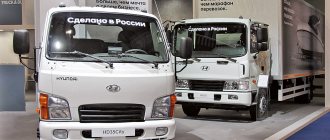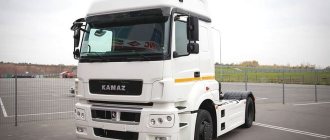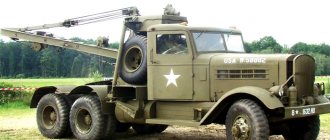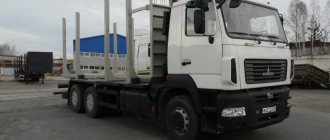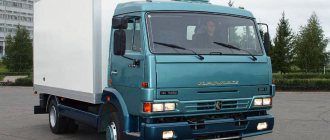2K 7 min.
Sales of commercial vehicles in Russia are recovering from the decline of the previous two years. But, as in the passenger segment, a surge in demand amid lockdowns, production and logistics problems led to a shortage of cars.
Photo: Getty Images
Photo: Getty Images
After a decline in demand over the past two years, the commercial vehicle market has revived this year: according to Autostat, in the first five months of this year, sales of medium- and large-tonnage trucks in Russia (gross weight over 3.5 tons) amounted to 36.5 thousand units, which is 38% more than in the same period last year. The demand for light commercial vehicles (LCVs) has increased even more: in the first five months of 2022, the volume of this market reached 52.2 thousand units, which is 50.2% more than in the same period of 2020.
Of course, the figures for such a strong rise are related to the low base of last year, when the lockdown and pandemic hit commercial vehicle sales hard. However, compared to the year before last, the current figures look good: truck sales increased by 24% compared to the first five months of 2019 (29.5 thousand trucks were sold on the market then), LCV sales by 27% (41 thousand). light commercial vehicles).
Demand for commercial vehicles is determined by several key factors.
Get it before prices go up
Historically record levels of demand for commercial vehicles in Russia were recorded nine years ago, when in 2012, sales of, for example, trucks reached 129 thousand units. Then, after the crisis and devaluation of the ruble, sales fell by more than half: the market bottomed out in 2015, when 51 thousand trucks were sold. Later, the segment began to gradually emerge from the failure: in 2022, dealers were already able to sell 82.3 thousand cars. But the latest economic turbulence pulled sales of commercial vehicles down: in 2022, the market retreated by 2%, to 80.7 thousand units, and in 2020 it lost ground by 9%, to 74.7 thousand units.
The current increase in demand in the commercial vehicle market, unfortunately, does not indicate a growing wealth of the customer base. The point is different: as in the case of passenger cars, the price tags for trucks change upward almost every month. And fleet owners reasonably strive to buy vehicles before prices rise.
“Sales of commercial vehicles in Russia are primarily affected by rising prices,” states investment analyst Evgeniy Mironyuk. “Business costs are growing, including those associated with the production of commercial vehicles, and prices for materials are increasing. According to Rosstat, for example, the industrial goods producer price index in June 2022 increased by 19.9% compared to December 2020. In such conditions, buyers of commercial vehicles are rushing to make a purchase at old prices as quickly as possible.”
“The demand for commercial vehicles in Russia is increasing due to three factors,” says Dmitry Parfenov, head of the Japanese sales department. “Firstly, there is a low base effect caused by a drop in orders last year, when quarantine restrictions were introduced due to the coronavirus pandemic, therefore logistics operators have slowed down the renewal of their own fleets. Secondly, there is an increase in freight traffic caused by the recovery of the domestic market. Thirdly, the rise in price of rolled steel could have played a certain role, and individual carriers began to buy new cars, based on the possibility of their strong rise in price, since the rise in steel prices pushes up the prices of cars.”
Commercial vehicle market in 2022: decline, but not collapse
The pandemic, economic crises, unfavorable political events - all this did not bode well for the commercial transport market in our country. Many forecasts promised an almost two-fold drop in sales. Fortunately, they did not succeed in coming true. According to the Autostat agency, no collapse occurred, but there is only another, albeit significant, market drawdown.
| Sales of new trucks (weighing more than 3.5 tons), pcs. | |||
| Brand | 2020 | 2019 | % |
| KAMAZ | 27 768 | 27 610 | 0,6 |
| GAS | 6 820 | 8 867 | –23,1 |
| Scania | 4 924 | 5 621 | –12,4 |
| Volvo | 4 486 | 5 655 | –20,7 |
| Ural | 4 067 | 3 196 | 27,3 |
| MAN | 3 833 | 5 015 | –23,6 |
| MAZ | 3 729 | 3 847 | –3,1 |
| Mercedes | 3 381 | 4 132 | –18,2 |
| Isuzu | 2 632 | 3 077 | –14,5 |
| DAF | 1 698 | 2 584 | –34,3 |
| Shacman | 1 698 | 1 391 | 22,1 |
| Hyundai | 1 232 | 1 168 | 5,5 |
| NefAZ | 1 112 | 1 040 | 6,9 |
| Hino | 1 093 | 1 199 | –8,8 |
| SAZ | 933 | 964 | –3,2 |
| IVECO | 853 | 1 313 | –35,0 |
| Renault | 846 | 1 218 | –30,5 |
| Jac | 698 | 502 | 39,0 |
| Faw | 688 | 394 | 74,6 |
| Fuso | 686 | 510 | 34,5 |
| Howo | 470 | 464 | 1,3 |
| Ford | 447 | 288 | 55,2 |
| Foton | 232 | 199 | 16,6 |
| XCMG | 126 | 83 | 51,8 |
| Daewoo | 84 | 65 | 29,2 |
| Other | 244 | 243 | 0,4 |
| Total | 74 780 | 80 645 | –7,3 |
It had the greatest impact on sales of heavy trucks: in 2020 they decreased by 7.3% compared to 2019. At the same time, the market leader, the KAMAZ company, sales not only did not fall, but even slightly increased - by 0.6%. The leader in its range is still the all-wheel drive model 43118. But if its sales nevertheless decreased slightly (by 4.4%, or by 300 vehicles), then the KAMAksor tractors model 5490, occupying second place, confidently increased by 6.3% compared to last year.
| Sales of new trucks by model, pcs. | |||
| Model | 2020 | 2019 | % |
| KAMAZ-43118 | 6 485 | 6 785 | –4,4 |
| KAMAZ-5490 | 5 592 | 5 259 | 6,3 |
| Lawn Next | 4 966 | 6 031 | –17,7 |
| KAMAZ-65115 | 4 682 | 5 263 | –11,0 |
| KAMAZ-6520 | 3 227 | 2 715 | 18,9 |
| Volvo FH | 3 008 | 3 709 | –18,9 |
| Mercedes Actros | 2 892 | 2 853 | 1,4 |
| Scania R | 2 090 | 1 984 | 5,3 |
| MAN TGS | 1 755 | 2 172 | –19,2 |
| MAN TGX | 1 667 | 2 556 | –34,8 |
| DAF XF | 1 596 | 2 476 | –35,5 |
| Volvo FM | 1 456 | 1 929 | –24,5 |
| Scania G | 1 315 | 1 819 | –27,7 |
| Scania P | 1 293 | 1 722 | –24,9 |
| GAZ-3308 | 1 221 | 1 931 | –36,8 |
| Ural-4320 | 1 115 | 1 480 | –24,7 |
| Hyundai HD 78 | 1 077 | 1 021 | 5,5 |
| Ural Next | 980 | 287 | 241,5 |
| NefAZ-4514 | 894 | 764 | 17,0 |
| Isuzu NPR | 891 | 968 | –8,0 |
| Shacman SX3258 | 883 | 0 | — |
| KAMAZ-43253 | 865 | 961 | –10,0 |
| KAMAZ-53605 | 851 | 1 159 | –26,6 |
| MAZ-6312 | 806 | 834 | –3,4 |
| KAMAZ-6580 | 762 | 459 | 66,0 |
| Other | 22 411 | 23 508 | –4,7 |
| Total | 74 780 | 80 645 | –7,3 |
Well, the most serious growth was shown by the Miass Urals: sales immediately increased by 27.3%. Moreover, if the classic 4320 family dropped in sales by almost a quarter (from 1,480 units in 2019 to 1,115 in 2020), then cars of the Next family showed literally explosive growth: if in 2022 only 287 units were sold, then in the past - almost a thousand.
But GAZ, on the contrary, lost a lot: in 2022 it managed to sell only 6,820 trucks compared to almost nine thousand in 2019. At the same time, the bulk of sales comes from Lawn Next, which lost 17.7% over the year. However, perhaps this year the situation at the Gorky plant will be improved by the new Valdai, which we recently talked about in detail.
| Trucks of European brands on the Russian market, pcs. | |||
| Brand | 2020 | 2019 | % |
| Scania | 4 924 | 5 621 | –12,4 |
| Volvo | 4 486 | 5 655 | –20,7 |
| MAN | 3 833 | 5 015 | –23,6 |
| Mercedes | 3 381 | 4 132 | –18,2 |
| DAF | 1 698 | 2 584 | –34,3 |
| IVECO | 853 | 1 313 | –35,0 |
| Renault | 846 | 1 218 | –30,5 |
But it’s not easy for Europeans in our market. Among the G7 representatives, the struggle was clearly not about who would add more, but about minimizing losses - everyone seriously lost. The situation is least dire for the Swedes: Scania and Volvo lost 12.4% and 20.7% of the market, respectively, and took first and second places among Western manufacturers. Well, sales of such brands as DAF, IVECO and Renault declined the most.
| Sales of new light commercial vehicles, units | |||
| Brand | 2020 | 2019 | % |
| GAS | 44 481 | 50 704 | –12,3 |
| UAZ | 14 531 | 17 320 | –16,1 |
| Ford | 13 970 | 13 000 | 7,5 |
| Lada | 12 610 | 11 090 | 13,7 |
| Volkswagen | 4 129 | 5 709 | –27,7 |
| Peugeot | 3 362 | 3 133 | 7,3 |
| Mercedes | 3 225 | 3 323 | –2,9 |
| Hyundai | 2 378 | 2 663 | –10,7 |
| Citroen | 2 270 | 1 980 | 14,6 |
| Fiat | 1 250 | 1 067 | 17,2 |
| Other | 2 105 | 2 216 | –5,0 |
| Total | 104 311 | 112 205 | –7,0 |
The market for light commercial vehicles dropped slightly less than that of heavy trucks: the loss compared to last year was seven percent. The leader here is still GAZ, whose sales, however, fell by 12.3%. Gazelle Next continues to be the undisputed leader, but in 2022 it also showed a decrease of 14.7% - which is as many as 4,316 cars.
UAZ took second place - mainly due to the abundance of models in the range, because none of them rose above fifth place in the overall statistics. Actually, the cargo-passenger version of the “loaf” with the index 3909 settled on it, sales of which decreased by 10% last year. As for the new UAZ-Profi lorry, its sales are stalling, just like the rear-wheel drive off-road versions of this truck: they fell by 31.6%, or 1,122 vehicles.
| Sales of new light commercial vehicles by model, pcs. | |||
| Model | 2020 | 2019 | % |
| Gazelle Next | 25 017 | 29 333 | –14,7 |
| Ford Transit | 13 867 | 12 618 | 9,9 |
| Lada Largus | 10 904 | 9 260 | 17,8 |
| GAZ-3302 | 10 318 | 10 756 | –4,1 |
| UAZ-3909 | 7 356 | 8 176 | –10,0 |
| GAZ-2752 | 3 734 | 3 572 | 4,5 |
| UAZ-Profi | 2 424 | 3 546 | –31,6 |
| GAZ-3221 | 1 799 | 3 027 | –40,6 |
| UAZ-2206 | 1 779 | 2 085 | –14,7 |
| Mercedes V-Class | 1 692 | 1 548 | 9,3 |
| Other | 25 421 | 28 284 | –10,1 |
| Total | 104 311 | 112 205 | –7,0 |
Against this background, amazing growth is demonstrated by Ford, which managed to sell almost a thousand more cars in 2022 than in 2019. At the same time, Transit, having added as much as 10% compared to last year, confidently outstripped not only the old Gazelles, but also VAZ’s “heeled” Largus, the sales of which, by the way, also increased significantly.
| Sales of new buses, pcs. | |||
| Brand | 2020 | 2019 | % |
| GROOVE | 6 348 | 8 049 | –21,1 |
| LiAZ | 2 514 | 1 610 | 56,1 |
| NefAZ | 1 551 | 1 053 | 47,3 |
| MAZ | 693 | 466 | 48,7 |
| KAvZ | 423 | 424 | –0,2 |
| Volgabus | 311 | 401 | –22,4 |
| Yuotong | 274 | 590 | –53,6 |
| KAMAZ | 205 | 170 | 20,6 |
| Higer | 164 | 257 | –36,2 |
| MAN | 134 | 98 | 36,7 |
| Other | 548 | 715 | –23,4 |
| Total | 13 165 | 13 833 | –4,8 |
Well, the slightest decline was shown by the Russian bus market: it lost 4.8% compared to the results of 2022. Representatives of the GAZ Group take precedence. PAZ is slowly losing ground (minus 21.1% compared to 2022), but thanks to the mass and inexpensive models 3205 and 3204, it maintains its leadership. LiAZ, on the contrary, thanks to deliveries to cities across the country, increased sales by more than half. Similar results in percentage terms are demonstrated by its subsidiary NefAZ, which occupies third place. The Belarusian MAZ also added: last year almost 700 buses of this brand were sold.
| Sales of new buses by model, pcs. | |||
| Model | 2020 | 2019 | % |
| PAZ-3205 | 3 168 | 3 604 | –12,1 |
| PAZ-3204 | 1 967 | 2 700 | –27,1 |
| LiAZ-5292 | 1 758 | 718 | 144,8 |
| NefAZ-5299 | 1 551 | 1 053 | 47,3 |
| PAZ-4234 | 963 | 1 193 | –19,3 |
| LiAZ-4292 | 368 | 238 | 54,6 |
| KAvZ-4238 | 242 | 316 | –23,4 |
| MAZ-203 | 241 | 44 | 447,7 |
| LiAZ-6213 | 235 | 382 | –38,5 |
| KAMAZ-6282 | 205 | 170 | 20,6 |
| Other | 2 467 | 3 415 | –27,8 |
| Total | 13 165 | 13 833 | –4,8 |
The successes of foreigners are much more modest. The Chinese's sales have seriously declined, and among Europeans only MAN made it into the top ten - and that was thanks to a large contract for Mosgortrans, which was concluded back in 2022.
Russian brands are on the defensive
The segment of commercial vehicles is still dominated by Russian ones; according to the results of the first five months of this year, the leader in the segment of trucks is KamAZ with 13 thousand vehicles (sales growth by 34.9%), as well as GAZ (3.5 thousand, growth 34.3%). Thus, together with Ural, which is in seventh place (1.8 thousand, an increase of 23.8%), Russian brands now occupy 21% of all sales. Other key players include foreign brands Scania (2.8 thousand, growth 107%), MAZ (2.2 thousand, +95%), Mercedes-Benz (1.5 thousand, +27%) (see. table 1).
In the LCV segment, domestic brands are also at the top, and even with a higher total share of sales. This year, GAZ sold 21.5 thousand cars (an increase of 37%), and UAZ and Lada, which are in third and fourth places, sold 6.8 thousand and 6.4 thousand, respectively (an increase of 31% and 91%). Thus, Russian manufacturers in the LCV segment account for more than 40% of all sales.
Used truck market
Among Russian regions, the Moscow region has become the leader in terms of used truck market capacity. In the region, based on the results of January-April 2022, used trucks were sold for 14.7 billion rubles. Also in the top three were the Krasnodar Territory and Moscow, where 9.8 billion rubles were spent on the purchase of used trucks. and 9.6 billion rubles. respectively.
In all TOP-10 regions, positive dynamics of financial capacity remained. This is due to an increase in the weighted average price and sales of used trucks in these regions. In the Samara region, despite the reduction in demand for trucks in the secondary market, the positive dynamics of financial capacity also remained.
Weighted average prices and financial capacity of the market for used trucks, TOP-10 regions, January-April 2022
| Region | Weighted average price, rub. | Dynamics, 2021/2020, % | Capacity, million rubles. | Dynamics, 2021/2020, % |
| Moscow region | 2 414 440 | 10,0 | 14 745 | 39,4 |
| Krasnodar region | 2 256 283 | 21,9 | 9 761 | 56,7 |
| Moscow | 2 724 649 | 16,9 | 9 591 | 52,9 |
| Saint Petersburg | 2 632 047 | 12,3 | 7 872 | 35,2 |
| Tatarstan Republic | 2 335 374 | 13,2 | 6 810 | 15,2 |
| Rostov region | 1 980 759 | 16,9 | 5 104 | 39,0 |
| Khanty-Mansi Autonomous Okrug | 2 580 209 | 6,5 | 4 786 | 35,5 |
| Nizhny Novgorod Region | 2 160 254 | 28,5 | 4 370 | 56,6 |
| Sverdlovsk region | 2 085 099 | 15,2 | 4 224 | 23,7 |
| Samara Region | 2 288 558 | 21,1 | 4 156 | 14,6 |
Source: Russian Automotive Market Research
In January-April 2022, KAMAZ became the leader in financial results. During the period under review, 50.0 billion rubles were spent on the purchase of used trucks of this brand. Also in the top three in terms of market capacity were the brands SCANIA (RUB 19.5 billion) and MAN (RUB 19.0 billion).
Brands from the TOP-10 showed positive dynamics of financial results, with the exception of the URAL brand, which was caused by a decrease in sales of used cars of this brand.
Leading brands in the Russian market of trucks (gross weight over 3.5 tons).
| KAMAZ | 13 014 | 34,9 | |
| 2 | GAS | 3 559 | 34,3 |
| 3 | Scania | 2 892 | 107,3 |
| 4 | MAZ | 2 299 | 95 |
| 5 | Volvo | 2 000 | 4,2 |
| 6 | MAN | 1 910 | 33,1 |
| 7 | Ural | 1 876 | 23,8 |
| 8 | Mercedes-Benz | 1 544 | 27,6 |
| 9 | Isuzu | 860 | -31,6 |
| 10 | Shacman | 608 | 17,6 |
| Total | 36 566 | 38,2 | |
Source: Autostat.
Among the “foreigners,” significant positions are occupied by Ford (7 thousand, an increase of 68%), the brands of the new Stellantis alliance are gaining momentum - Peugeot, Citroen, Opel (2.4 thousand, 1.3 thousand, 0.8 thousand), The positions of the German brands Volkswagen and Mercedes-Benz are strong (2.3 thousand, 1.5 thousand) (see Table 2).
“GAZ cars remain the most successful brands in the light commercial vehicle segment due to a wide model range, improved product quality and one of the most competitive price offers on the market,” comments Andrey Gusev, deputy director of the corporate sales department of the Avilon car dealer. “Ford Transit has excellent results. , this is one of the most attractive products in terms of price-quality ratio and the availability of a very wide range of models. Lada Largus is a bestseller in the small heel van segment due to its lowest price. The PSA concern has good performance: the “twins” Peugeot, Citroen, and more recently Opel are modern representatives of LCVs, they are produced in Russia and sold at attractive prices.”
As for the most active consumers of commercial vehicles, now, according to market participants, significant purchases in the LCV segment are made, for example, by the state and companies associated with online trading. “Sales in the light commercial vehicle segment are traditionally influenced by government procurement, for example, for the needs of medicine and law enforcement agencies, as well as the rapid growth of online retail and the growth of order delivery companies, courier and postal services related to this business,” says Andrey Gusev .—The general state of the economy in the country traditionally has a strong influence on sales of commercial vehicles: if growth is planned in the economy, then vehicle fleets are renewed more actively.”
Dynamics of average prices in the secondary market of commercial vehicles and used special equipment
Based on the results of 2022, the average cost of used trucks increased by 10% and amounted, according to Avito Auto, to 550,000 rubles.
The most noticeable increase in prices at the end of last year was shown by loaders (all types), the average price for which reached 900,000 rubles (+28.6%). The average price in the “light commercial vehicle” category increased by 5.7%, amounting to 370,000 rubles, and prices for tractors increased by an average of 3.2%. Average cost of used commercial vehicles and special equipment by quarter and price dynamics, all of Russia, 2022.
| price, rub. | Price, change over the year, % | |||||||
| I quarter 2022 | II quarter 2022 | III quarter 2022 | IV quarter 2022 | I quarter 2022 | II quarter 2022 | III quarter 2022 | IV quarter 2022 | |
| All types | 500 000 | 500 000 | 510 000 | 550 000 | 0,2 | 4,2 | 5,2 | 10,0 |
| Trucks | 510 000 | 550 000 | 550 000 | 600 000 | 2,0 | 12,2 | 12,2 | 17,6 |
| Light commercial vehicles | 360 000 | 370 000 | 375 000 | 380 000 | 2,9 | 7,2 | 7,1 | 5,6 |
| Loaders | 790 000 | 900 000 | 910 000 | 980 000 | 12,9 | 28,6 | 21,3 | 24,1 |
| Trailers | 220 000 | 190 000 | 200 000 | 200 000 | –4,3 | –13,6 | –13,0 | –9,1 |
| Tractors | 1 300 000 | 1 350 000 | 1 250 000 | 1 250 000 | 0,0 | 6,3 | 4,2 | –3,8 |
There are not enough cars
The increased demand for commercial vehicles this year has led to the emergence of such a seemingly alien phenomenon for a market economy as a shortage. Just like in the passenger car segment, there is now an acute shortage of trucks in dealer warehouses. This applies especially to foreign brands: dealers of Scania, Volvo, MAN, and Mercedes complain about the shortage of cars. The waiting period for car deliveries is often impressive; it exceeds the delays for passenger cars, reaching a period of several months to a year or more. “Today, the waiting period for a commercial vehicle is at least two months, and among the most popular models, orders are accepted a year in advance. Thus, in the cargo segment, orders for cars of the Volvo, Mercedes-Benz and Scania brands are scheduled for several months,” says Ilya Molchanov, general director for sales of commercial vehicles at the auto dealer AutoSpetsCenter Kotlyakovka.
“Demand on the market exceeds supply, we have now already closed orders for the second quarter of 2022,” continues Scania Sales Director in Russia Leonid Tkachik. “The pandemic dealt a severe blow to the automotive industry, causing a sharp reduction in demand, suspension of production, disruption of usual connections between producers, suppliers and consumers. An acute problem remains the shortage of semiconductor components and microcircuits, which limits the production capabilities of the industry. The recovery of the auto industry will largely depend on the stabilization of the situation on the auto electronics market and overcoming global disruptions in production chains.”
“We now see high demand for cars from a variety of customers; traditionally, dump trucks with a 6x4 and 8x4 wheel arrangement are in high demand among our clients,” says Andrey Popov, director of the FAW truck sales department in Russia. “This situation is caused by a shortage of equipment, now “All of it is delivered to order, the waiting period is on average two to three months, when a car appears in stock - this is very rare.”
Demand for LCVs in 2021 by regions of Russia
First place in terms of demand for new vehicles from the LCV category was taken by Moscow and the Moscow region, showing 14.12% of all-Russian demand. The average price of a light commercial vehicle in this region was about 1.7 million rubles.
St. Petersburg and the Leningrad region moved up to second place. The region accounted for a little more than 11.5% of the country’s total demand, although the price of one vehicle turned out to be significantly higher than average and exceeded 2.1 million rubles.
In the case of LCV, the Republic of Tatarstan slightly lost ground and turned out to be the owner of “bronze” in this rating with a result of 5.09%. The average price of a car in the region turned out to be slightly higher than in Moscow, but significantly lower than in St. Petersburg and amounted to 1.744 million rubles.
In two other regions from the top five, the Republic of Bashkortostan and the Krasnodar Territory, the average price of one LCV unit in 2021 was 1.449 million rubles and 1.517 million rubles, respectively, while their share of federal demand was 4.78% and 4.29 %.
Price rises and shortages will continue
Companies will have to promote their new products on the market in conditions of ongoing fever: rising prices, shortages of auto components, and an unpredictable situation with the demand for road transportation. “The increase in prices for commercial vehicles will continue next year,” predicts Alexander Osin. “However, it is important to note that car manufacturers pass on their rising costs to consumers gradually, so in the near future we can expect moderate growth in prices for commercial vehicles in the range of 10-15 percent.”
According to analysts, the market will be restrained by the high level of debt load of both the population and the corporate sector. Leasing sales are also approaching the ceiling, which, for example, in the truck segment has already reached 80% of the total truck sales in the Russian Federation. However, there is good news for the commercial vehicle market: in some segments, demand for logistics is likely to continue to grow.


